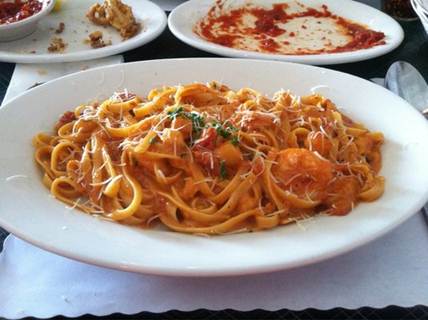A graduate of the Peregrine School of
Cordon Blue London, Jun Jun de Guzman is a popular chef instructor as well as
programs director at the Center for Asian Culinary Studies in San Juan. (His
students and friends fondly call him “Chefie”). He is also a member if the
Council of Chefs of the USDA-FAS. Whenever he can, he heads abroad for further
studies. Most recently, he was at the UFM Baking School in Bangkok where he
took the US Wheat course on Frozen Dough Technology and classes at the Macaron
Pastry Training Center with Chef Eric Perez.

Jun
Jun de Guzman
We all grew up eating pasta and I’m no
exception. I remember the sweet spaghetti that was always served during
birthday parties – the noodles were always overcooked and most people thought
that was the way pasta was supposed to be.
But really, noodles should be cooked al
dente, which means “to the tooth”. There should be a little resistance when you
bite the noodles; they should not be soft or overdone. So how can you achieve
this? First, cook the noodles in plenty of water, about 4 liters for every 450
to 500 grams of pasta. Second, cover your pot until the water starts boiling
then add a handful of salt. This will give your pasta more flavor and it’ll
make the noodles porous so that they adsorb the sauce they are tossed in. after
adding the salt, add the noodles and mix, making sure the boiling water covers
the pasta. The noodles should spread out and shouldn’t stick together. Third,
don’t add oil! It isn’t necessary and will just make the noodles too slippery
for the sauce to adhere to them. Fourth, time is a critical factor when cooking
pasta. The difference between al dente and overcooked is just a few seconds!
Carefully read the packaging instructions and remember that cooking time may
differ between brands. But the best way to know if your pasta is al dente is to
bite into a noodle and check if it’s still firm. (Make sure though that the
noodles are cooked through – the middle of the noodle shouldn’t be white). Once
al dente, immediately remove the noodles from the hot water and drain in a
colander. Add the noodles to the sauce, toss (Italians never present pasta
dishes with the noodles separate from the sauce), then serve immediately. You
don’t want the pasta sitting out for too long. Noodles aren’t made to wait for
the sauce, so make sure to cook your sauce ahead. Give the dish a sprinkling of
grated cheese and you’re good to go!
Pasta in shrimp pink sauce
Serves: 5 to
6
Prep time:
20 to 25 minutes
Cooking time: 15 minutes

Pasta
in shrimp pink sauce
·
200 to 300 grams shrimp, unshelled
·
1/3
cup extra virgin olive oil
·
2 tablespoons minced garlic
·
1½ tablespoons tomato paste dissolved in ½ cup
white wine
·
1½ teaspoons fresh oregano leaves
·
1 teaspoon salt
·
¼ teaspoon cayenne pepper
·
¾ cup heavy cream
·
500 grams pasta, cooked al dente
·
Parsley sprigs for garnish
1.
Shell and devein shrimp. Slice shrimp in half
lengthwise and rinse.
2.
In a pan, heat olive oil and sauté tomato paste
mixture. Cook for 3 to 5 minutes.
3.
Add shrimp and cook until pink. Add fresh
oregano leaves. Turn off fire and season with salt and cayenne pepper.
4.
Using a ladle, scoop out half of the mixture and
purée in a blender. Return to the pan. Turn on fire and cook at medium heat for
2 minutes. Pour in heavy cream. Boil then simmer for 2 minutes.
5. Add cooked pasta and toss in sauce. Garnish with parsley. Serve
immediately.